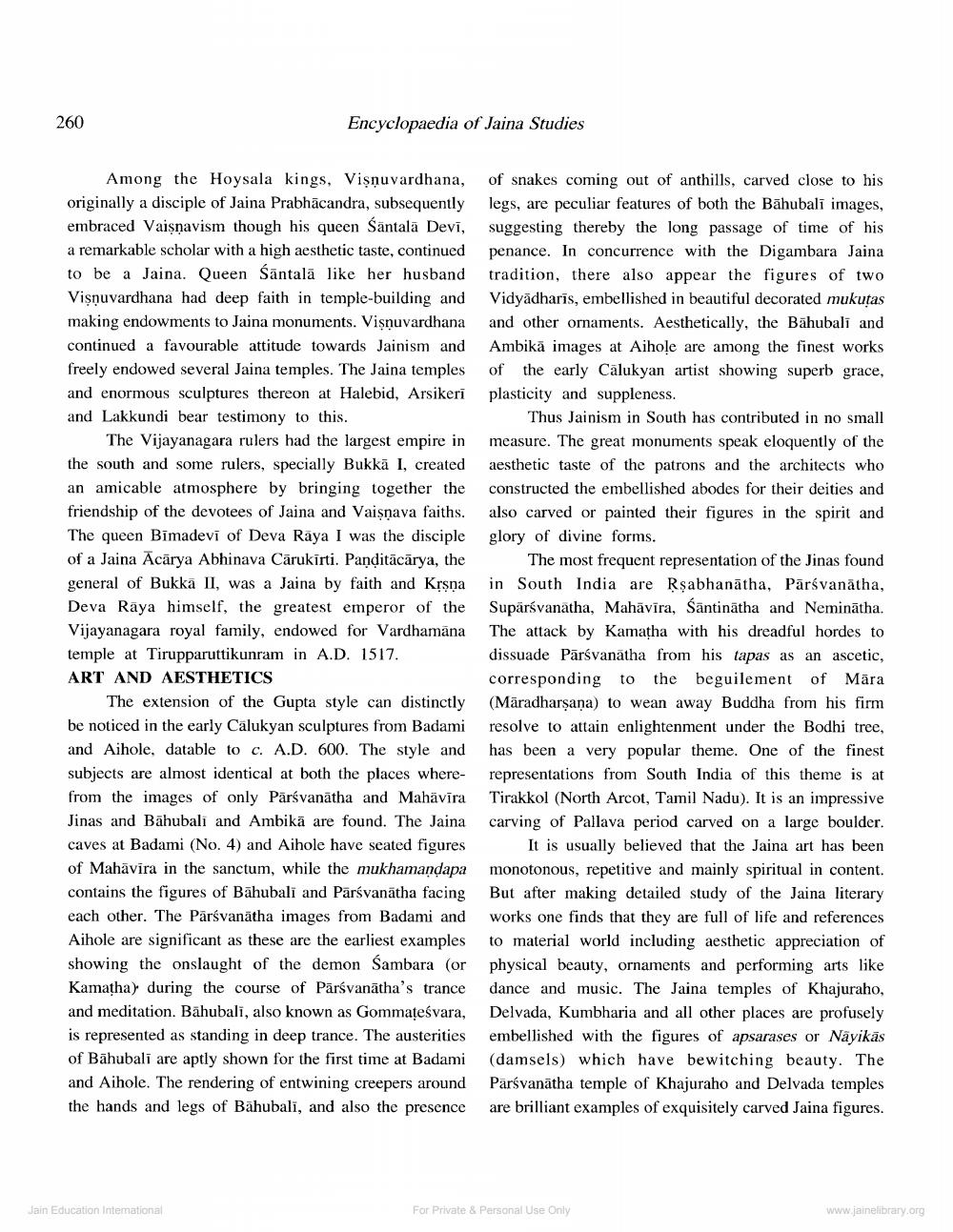________________
260
Encyclopaedia of Jaina Studies
Among the Hoysala kings, Vişnuvardhana, originally a disciple of Jaina Prabhācandra, subsequently embraced Vaisnavism though his queen Säntalā Devī, a remarkable scholar with a high aesthetic taste, continued to be a Jaina. Queen Santalā like her husband Visnuvardhana had deep faith in temple-building and making endowments to Jaina monuments. Vişnuvardhana continued a favourable attitude towards Jainism and freely endowed several Jaina temples. The Jaina temples and enormous sculptures thereon at Halebid, Arsikeri and Lakkundi bear testimony to this.
The Vijayanagara rulers had the largest empire in the south and some rulers, specially Bukkā I, created an amicable atmosphere by bringing together the friendship of the devotees of Jaina and Vaişnava faiths. The queen Bīmadevi of Deva Raya I was the disciple of a Jaina Acārya Abhinava Cārukirti. Panditācārya, the general of Bukka II, was a Jaina by faith and Krsna Deva Raya himself, the greatest emperor of the Vijayanagara royal family, endowed for Vardhamāna temple at Tirupparuttikunram in A.D. 1517. ART AND AESTHETICS
The extension of the Gupta style can distinctly be noticed in the early Calukyan sculptures from Badami and Aihole, datable to c. A.D. 600. The style and subjects are almost identical at both the places where- from the images of only Pärśvanātha and Mahāvīra Jinas and Bahubali and Ambikā are found. The Jaina caves at Badami (No. 4) and Aihole have seated figures of Mahāvīra in the sanctum, while the mukhamandapa contains the figures of Bāhubali and Parsvanātha facing each other. The Pārsvanätha images from Badami and Aihole are significant as these are the earliest examples showing the onslaught of the demon Sambara (or Kamatha) during the course of Pārsvanātha's trance and meditation. Bāhubali, also known as Gommațeśvara, is represented as standing in deep trance. The austerities of Bāhubali are aptly shown for the first time at Badami and Aihole. The rendering of entwining creepers around the hands and legs of Bāhubali, and also the presence
of snakes coming out of anthills, carved close to his legs, are peculiar features of both the Bahubali images, suggesting thereby the long passage of time of his penance. In concurrence with the Digambara Jaina tradition, there also appear the figures of two Vidyādharīs, embellished in beautiful decorated mukutas and other ornaments. Aesthetically, the Bāhubali and Ambikā images at Aihole are among the finest works of the early Calukyan artist showing superb grace, plasticity and suppleness.
Thus Jainism in South has contributed in no small measure. The great monuments speak eloquently of the aesthetic taste of the patrons and the architects who constructed the embellished abodes for their deities and also carved or painted their figures in the spirit and glory of divine forms.
The most frequent representation of the Jinas found in South India are Rşabhanātha, Pārsvanātha, Supärśvanatha, Mahāvīra, Säntinätha and Neminātha. The attack by Kamatha with his dreadful hordes to dissuade Pārsvanātha from his tapas as an ascetic, corresponding to the beguilement of Māra (Māradharşana) to wean away Buddha from his firm resolve to attain enlightenment under the Bodhi tree, has been a very popular theme. One of the finest representations from South India of this theme is at Tirakkol (North Arcot, Tamil Nadu). It is an impressive carving of Pallava period carved on a large boulder.
It is usually believed that the Jaina art has been monotonous, repetitive and mainly spiritual in content. But after making detailed study of the Jaina literary works one finds that they are full of life and references to material world including aesthetic appreciation of physical beauty, ornaments and performing arts like dance and music. The Jaina temples of Khajuraho, Delvada, Kumbharia and all other places are profusely embellished with the figures of apsarases or Nayikās (damsels) which have bewitching beauty. The Parsvanātha temple of Khajuraho and Delvada temples are brilliant examples of exquisitely carved Jaina figures.
Jain Education Intemational
ation Intermational
For Private & Personal Use Only
For Private & Personal Use Only
www.jainelibrary.org




